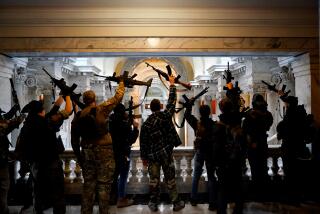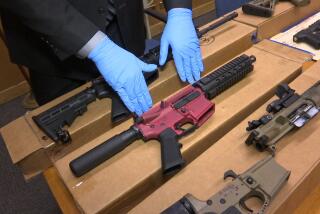Editorial: A new report affirms what we already know: Easier access to guns means more violent deaths

Studies have proved what common sense has already told us: Places that have more and easier access to guns tend to have more gun deaths. Now a new report by the Violence Policy Center reaffirms a similar link between looser gun-control laws and gun-suicide rates.
It stands to reason that suicidal people with easy access to firearms will find it easier to kill themselves on the spur of the moment, and studies also have found that connection between access to firearms and gun homicides. The link is there, too, in lethal acts of domestic violence including murder-suicides — a woman is five times more likely to be killed if she lives in a house with a gun, according to one study. It’s the guns that increase the lethality of a moment, whether it be a self-destructive impulse or a lover’s rage.
So who led the pack in gun-suicide rates, according to the Violence Policy Center? Montana, where two-thirds of households have firearms and where the gun-suicide rate was 15.54 per 100,000 residents, more than twice the national rate of 7.1. The lowest gun-suicide rate was in New Jersey, at 1.97 per 100,000, and where only 17.4% of households owned firearms. California’s gun-suicide rate was 4.06, with 27.2% of households owning firearms. And California maintains some of the toughest gun-control laws in the country, including bans on high-capacity magazines, limits on assault-style rifles, tight control of concealed carry permits, mandatory background checks, and restrictions on carrying a concealed weapon.
What to do about gun violence is the vexing and contentious question that Texas has been struggling with since the mass shooting two weeks ago in which 10 people were killed at Santa Fe High School. The incident was hardly Texas’s first encounter with such violence. It was just last November that a gunman killed 26 people at a church service in rural Sutherland Springs, southeast of San Antonio. Another gunman killed five Dallas police officers in July 2016, and two other gunmen killed 16 people in two separate shooting rampages at Ft. Hood in 2009 and 2014. And those are just the highest-profile cases; most gun deaths involve sole victims, and come on a daily basis. After the Parkland, Fla., school shooting, USA Today crunched numbers and ranked Texas 28th in the nation with a firearm death rate of 12.1 per 100,000; California was 43rd with a rate of 7.9.
Half of all suicides are done with a gun, and nearly three-quarter of homicides involve guns.
Given all that, the proposed fixes Texas Gov. Greg Abbott trotted out Wednesday were pretty underwhelming. He backed tightened requirements on gun storage and urged the Legislature “to consider the merits of adopting a red-flag law” like California’s, which allows relatives and law enforcement authorities to ask a judge to order firearms confiscated from someone deemed a risk to himself or to others. Abbott also proposed “hardening” college campuses by limiting access points and adding more trained and armed officers and school staff to campuses, as well as expanding mental health screening to try to predict violent behavior by troubled students. Notably few of the proposals had much to do with reducing access to firearms in the first place, which is not terribly surprising in one of the most reliably conservative states in the country.
But that’s exactly what’s needed, as studies and experience have shown. The gun lobby denies the connection between firearms and violence, or shrugs it off with the absurd argument that still more guns on streets and in schools will make us a safer society. The National Rifle Assn.’s embrace of the 2nd Amendment is uncompromising and near religious.
But it is far from acceptable that the nation endures 36,000 firearm deaths a year — some 13,000 of them homicides and 22,000 suicides. In fact, about half of all suicides are done with a gun, and nearly three-quarter of homicides involve guns. Better mental health and sharper security would help, but such measures nibble around the edges of the problem, which cannot be solved without addressing easy access to firearms.
Until we as a society, and an electorate, force change, we are going to have to accept daily death and occasional mass murder as a consequence of our complacency.
Follow the Opinion section on Twitter @latimesopinion or Facebook.
More to Read
A cure for the common opinion
Get thought-provoking perspectives with our weekly newsletter.
You may occasionally receive promotional content from the Los Angeles Times.










